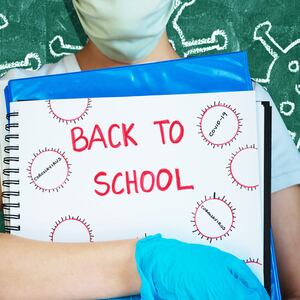Millions of frazzled parents who want to know if it’s safe to send their kids back to school in the middle of a coronavirus surge are turning to government leaders—who can’t stop squabbling long enough to give them an answer.
Across the country, state and local governments are battling over not just what should happen with schools this year, but who should get to make the decisions. In New York, the governor and mayor have criticized each other’s plans in the press, while parents in San Antonio are trapped in a three-way battle between the governor, school districts, and local health officials. Even the president is not immune from the infighting, as officials in Maryland battle over whether to shut down private schools—including one attended by Barron Trump.
“Parents feel confused and frustrated, and they feel like they can’t plan ahead,” said Inga Cotton, who runs a Facebook group for nearly 7,000 parents of school-age kids in San Antonio. “It’s just been a roller coaster. They‘re just getting thrown one way and the other."
In New York City—the largest school district in the country—the mayor and governor have engaged in a public war of words over how to reopen schools, leaving parents and teachers on edge. The disagreement started in April, when Mayor Bill de Blasio insisted that schools in the city would not reopen before the fall, while Gov. Andrew Cuomo suggested it was still possible. (The governor eventually relented in early May.)
Last week, when city officials published a 32-page reopening plan, Cuomo pushed back again, saying in a press call: “Just because a school district says ‘we’re open’ does not mean students are going to go.” A top adviser to the governor also criticized the city’s proposal as more of an “outline” than a plan, pointing out that it was shorter than a proposal devised by the nearby, smaller Yonkers school district.
De Blasio shot back Monday, saying he was “past the point of irritation” with Cuomo’s comments. His plan calls for reopening schools only if the city’s infection rate remains below 3 percent—it’s currently below 1 percent—and mandates a 24-hour shutdown for any school where people in two separate classes test positive. Masks and social distancing will be required, and children will only attend in-person classes one to three days a week.
“I just focus on the work and I focus on what I need to do for my fellow New Yorkers,” de Blasio said in a press conference. “I’m thinking about the parents, I’m thinking about the kids, I’m thinking about the educators.”
But parents say they could do with less rumination and more clear guidance from government leaders.
When Sheree Gibson, a parent and member of the Chancellor's Parent Advisory Council, organized a forum in Queens about the reopening plan this week, more than 1,000 people registered. Gibson told The Daily Beast that parents can’t plan for the fall when the governor and the mayor won't stop sniping.
“The governor says one thing, the mayor says another, then we’re left in limbo while they figure it out,” she said. “We did this in March, we don't want to do this now.”
In Montgomery County, Maryland, meanwhile, health officials issued an order barring both public and private schools from reopening through at least Oct. 1, setting off a firestorm among conservative pundits. Fueling the controversy was the fact that the order also shuttered St. Andrew's Episcopal School, the private institution attended by 14-year-old Barron Trump.
This week, Gov. Larry Hogan issued an executive order overruling that directive, saying the decision about whether or not to reopen should be up to the schools themselves. Montgomery County’s order, the governor said, was “overly broad and inconsistent with the powers intended to be delegated to the county health officer.”
But the county is not backing down. County Health Office Travis Gayles issued a second order Wednesday night requiring private schools to operate online-only and citing sections of the state code that gave him the power to do so. In a press conference, the county executive called Hogan's order “inappropriate” and “not a good decision.” (St. Andrew's had already issued a letter to parents siding with the county and announcing an online-only learning plan for the fall.)
In San Antonio, parents are trapped in a Venn diagram of orders from the state, local health officials, and school districts. Bexar County Health Authority Junda Woo declared last month that schools would not be able to reopen until at least Sept 7. But on July 28, Texas Attorney General Ken Paxton decreed—and Gov. Greg Abbott agreed—that school districts should be the ones to make this decision. At the same time, the Texas Education Commissioner declared that no school district would be allowed to delay in-person classes past eight weeks after the start of the semester, or they would lose funding.
Local education organizations like the Texas School Alliance and Texas Association of School Boards were pleased with power being vested in the districts, but seethed at the idea of being forced to reopen in eight weeks. Brian Woods, superintendent for Northside School District, threatened to take the state to court over the issue, telling a local NBC station that his schools would base their return to in-person education on public health measures, not government edicts.
Parents, meanwhile, were left wondering who exactly was in charge. Cotton said her Facebook group was three times as busy in July than in the months preceding—which were themselves twice as busy as any month in 2019.
“[Parents] just want to know, ‘On this day is my kid going to school, or do I need a babysitter? And how do I get a babysitter during COVID?’” she said. “It’s confusing to get contradictory information from different jurisdictions.”
“There's nothing anybody in politics can do to help the people with these unrealistic expectations that they would be kid-free, sipping a pumpkin spice latte come fall,” Cotton added. But for those with more realistic expectations, she said, “I think they want to know when it will be reasonably safe.”


